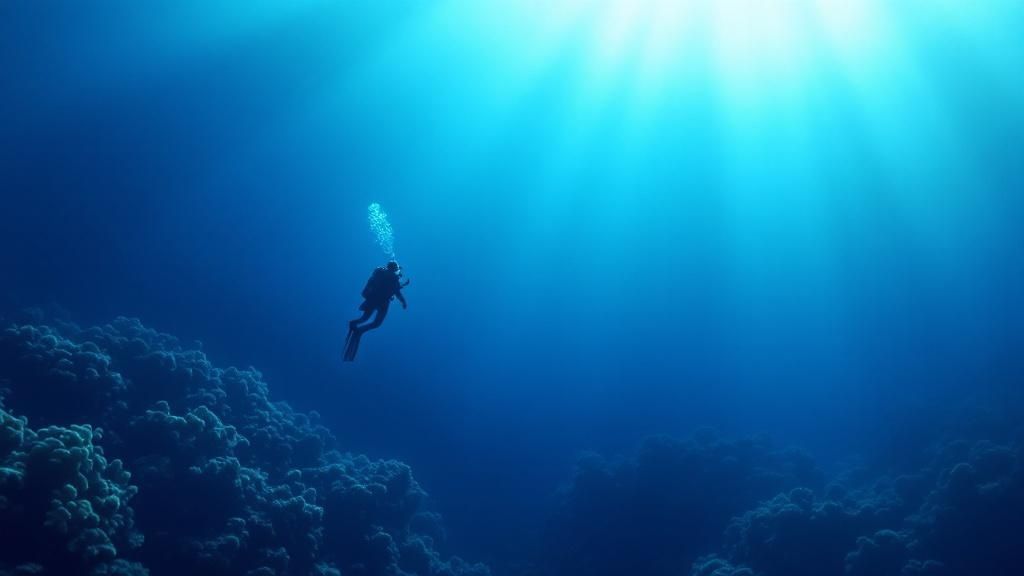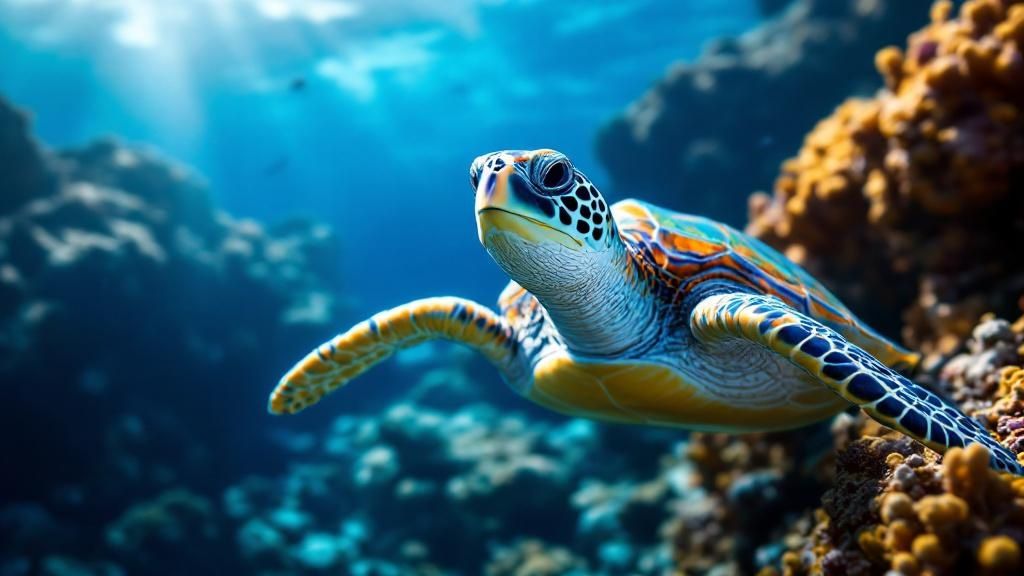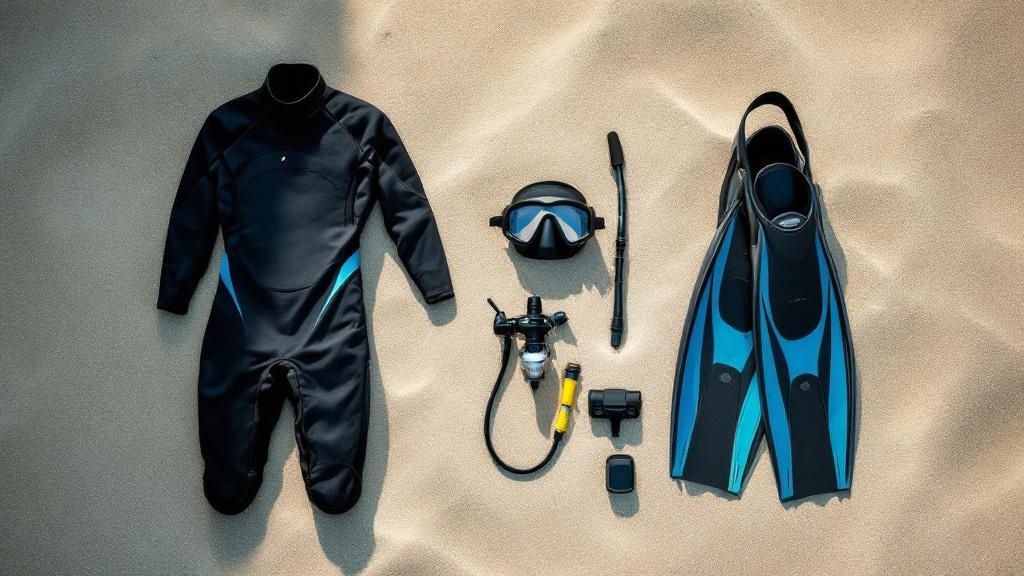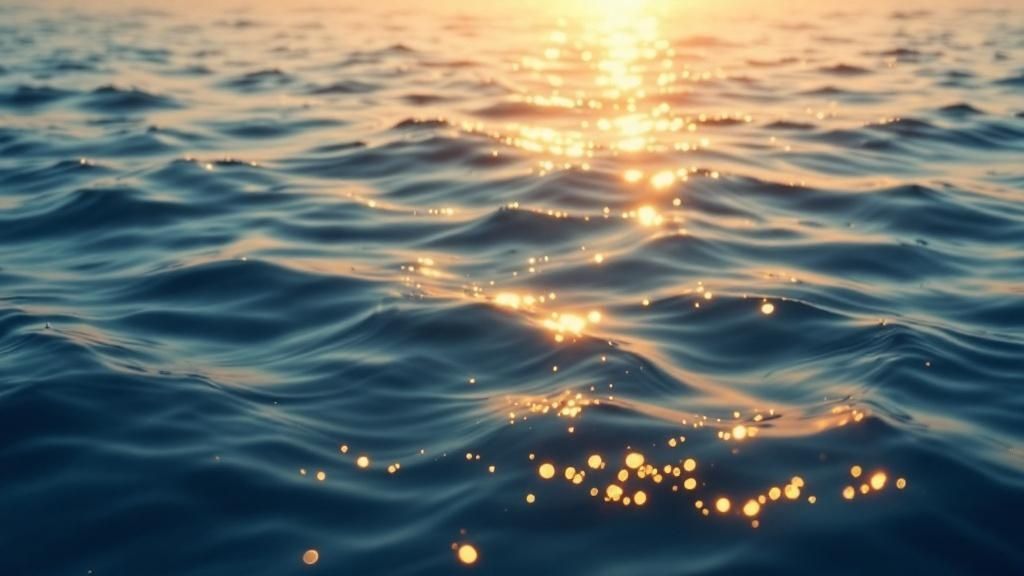Picture this: you descend into impossibly clear, turquoise water, drifting past ancient volcanic lava tubes as a kaleidoscope of marine life swirls around you. This is the heart of big island scuba diving, an experience that easily makes it one of the top dive destinations on the planet. The island's unique blend of dramatic underwater landscapes and vibrant sea creatures creates an adventure you simply won’t forget.
Why Diving the Big Island Is Unforgettable
The Big Island of Hawai‘i offers an underwater world shaped by the raw power of volcanic activity, making it unlike anywhere else. This isn’t just another tropical dive; it's an exploration of a submerged, dynamic landscape that’s still changing. For anyone planning a scuba diving Big Island Hawaii trip, the west coast—specifically Kona—is where all the action is.
Kona’s leeward coast is naturally sheltered from the strong trade winds, which blesses it with remarkably calm and clear waters pretty much year-round. This exceptional clarity often gives divers visibility of over 100 feet. When you’re diving Hawaii Big Island, it can feel like you’re flying through a massive underwater cathedral. Ancient lava flows have sculpted a stunning sub-aquatic world of archways, swim-throughs, and intricate lava tubes just waiting to be explored.

What really puts this place on the map is the sheer variety of experiences. It doesn't matter if you're a brand-new diver or a seasoned pro who’s seen it all—there's a dive site here for you.
- Vibrant Coral Gardens: The reefs here are just bursting with color and life, home to countless species of fish, eels, and crustaceans.
- Dramatic Volcanic Topography: You get to explore unique formations you won’t find anywhere else on Earth, a direct result of the island's fiery geological past.
- Abundant Marine Life: It’s common to run into green sea turtles (honu), playful spinner dolphins, and even majestic humpback whales during the winter.
- The World-Famous Manta Ray Night Dive: This is the big one—the bucket-list dive for so many. Witnessing giant manta rays gracefully feeding in the glow of dive lights is a magical, almost spiritual, encounter that defines Kona diving.
For many divers I’ve talked to, the combination of pristine conditions and unique wildlife makes scuba Big Island a place they come back to again and again. It’s more than just a dive; it’s a full immersion into a protected and thriving ecosystem.
A great example is the world-renowned Kealakekua Bay. It’s a protected marine sanctuary, and because fishing is prohibited, the marine life there is absolutely off the charts. You'll see a dense, active, and healthy underwater community that’s a powerful reminder of why we protect these special places. You can discover more about Kealakekua Bay’s protected waters right on our site. When you’re ready to see it for yourself, booking with one of the top-tier Kona diving companies ensures your adventure is both safe and spectacular.
If you're already picturing yourself in the water, take a look at our tour availability.
Quick Guide to Big Island Diving Highlights
To put it all in one place, here’s a quick look at what makes diving here so special. Each feature offers something a little different, catering to all kinds of divers.
| Feature | What Makes It Special | Best For |
|---|---|---|
| Crystal-Clear Water | Visibility often exceeds 100 feet, thanks to the sheltered Kona coast. | Underwater Photographers & Videographers |
| Volcanic Topography | Unique lava tubes, arches, and caverns found nowhere else. | Adventurous Divers & Explorers |
| Rich Marine Life | Reliable encounters with turtles, dolphins, and endemic Hawaiian fish. | Everyone, from beginners to seasoned pros |
| Manta Ray Night Dive | A world-famous, surreal experience watching giant mantas feed at night. | Bucket-List Chasers & Thrill-Seekers |
| Protected Sanctuaries | Sites like Kealakekua Bay are teeming with life due to conservation efforts. | Marine Life Enthusiasts & Conservationists |
| Year-Round Diving | Calm conditions prevail most of the year, offering a flexible travel schedule. | Divers looking for a reliable destination |
This combination is tough to beat. Whether you're here for the big animals or the bizarre lava formations, the Big Island delivers.
Discover the Top Big Island Dive Sites
So, you're ready to explore the underwater world of the Kona coast? Smart move. The Big Island diving experience is unlike any other, shaped by raw volcanic power and teeming with a kaleidoscope of life. We're going to walk you through the can't-miss spots that make scuba diving Big Island Hawaii a truly world-class adventure.

From pristine coral gardens to dramatic lava tubes, the underwater landscape here is simply in a league of its own. Every site has its own personality, which means there's a perfect dive waiting for you, no matter your skill level or what you're hoping to see.
The Manta Ray Night Dive
Let's get one thing straight: you can't talk about Kona diving without starting with the legendary manta ray night dive. Honestly, calling it just a "dive" doesn't do it justice. It's a full-on spectacle. Picture this: you're kneeling on the dark ocean floor as these gentle giants, some with wingspans up to 16 feet, glide, loop, and somersault just inches over your head.
It’s a brilliantly simple setup. We set up powerful underwater lights that attract swarms of plankton, the mantas' favorite meal. The mantas then put on a show, performing a mesmerizing ballet as they swoop in to feed in the light beams. It’s a surreal, bucket-list experience that’s consistently ranked as one of the best night dives on the planet. This nightly performance happens at a few key spots:
- Manta Village (Keauhou Bay): This is the original, classic site. It's incredibly reliable, with a success rate of over 90% for manta sightings.
- Manta Heaven (Garden Eel Cove): A bit further north, this spot often draws in an even larger group of mantas, creating a truly jaw-dropping underwater ballroom.
This encounter is the absolute pinnacle of diving Hawaii Big Island. The sheer size and effortless grace of these animals moving through the water is something that will stick with you forever. It's both humbling and completely awe-inspiring.
Kealakekua Bay Marine Sanctuary
When the sun is up, Kealakekua Bay is the crown jewel of daytime diving. It's a protected Marine Life Conservation District, meaning fishing is strictly limited. The result? An underwater ecosystem that is absolutely bursting with life and energy.
The bay is famous for its phenomenal water clarity and healthy coral reefs that gently slope down from the shore. You’ll find yourself surrounded by huge schools of colorful fish, you might run into the resident spinner dolphins, and you’re almost guaranteed to see a few green sea turtles (honu) chilling out on the reef. The centerpiece is the Captain Cook monument, a site that’s as rich in Hawaiian history as it is in marine life.
Lava Tubes and Underwater Arches
The island's volcanic past has created an incredible playground for divers who like a bit of adventure. Dotted all along the Kona coast are incredible lava formations that offer a completely different kind of thrill. Exploring these ancient structures is a massive part of the scuba diving Big Island experience.
- Lava Tubes: You can actually swim through tunnels formed by ancient lava flows. Sites like Golden Arches and Tube-a-licious offer safe, exhilarating swim-throughs that feel like exploring another world.
- Underwater Arches: These dramatic formations make for stunning photos and act as gathering spots for all sorts of marine life looking for shelter.
- Craters: Imagine diving inside a submerged volcanic crater. At spots like Au Au Crater, you can explore unique geological features and see the fascinating creatures that have made it their home.
While our boat dives get you to the most dramatic and remote locations, there are also some fantastic opportunities right from the shoreline. If you're the type who likes to just gear up and go, you can find out more in our guide to the best shore diving sites in Kona, Hawaii. It's the perfect way to add more bottom time to your trip and explore the incredible world of diving Big Island on your own schedule.
When Is the Perfect Time for Your Dive Trip?
Getting the timing right for your Big Island scuba diving trip can take it from good to absolutely unforgettable. While the Kona coast has spectacular conditions pretty much year-round, knowing the subtle shifts in weather, water temps, and marine life helps you nail down the perfect window for your adventure.
Truthfully, every season here has its own underwater magic.

The real beauty of diving Hawaii Big Island is its consistency. Because the island's massive volcanoes shield the coast from the prevailing trade winds, the Kona side stays incredibly calm and dive-friendly almost every single day. That reliability is a huge part of what makes planning a dive trip here so easy.
Fall: The Diver's Sweet Spot
Ask any local diver their favorite time to get in the water, and you'll hear a common answer: fall. From September through November, the summer heat starts to ease up, and the ocean conditions become just about perfect.
This is when the water is typically at its calmest and clearest. We're talking visibility that often pushes past 100 feet. It's the "sweet spot" for a few key reasons:
- Peak Conditions: You get that perfect combo of warm water, glassy seas, and jaw-dropping visibility.
- Fewer Crowds: The summer rush is over, which means dive sites are more serene and the whole vibe is more relaxed.
- Vibrant Marine Life: The reefs are buzzing with activity, with plenty of turtles, dolphins, and schools of colorful fish.
There's just nothing like descending into that placid, gin-clear water on a Kona autumn day. It feels like the ocean itself has taken a deep, calm breath, letting you soak in every detail.
Winter: The Season of Whales
Winter, from December through February, brings something truly special to scuba diving Big Island: the humpback whales. Even if you don't get a lucky underwater glimpse, their presence is undeniable.
Hearing their complex, haunting songs echoing through the water while you're exploring a lava tube is an experience that will stick with you forever. It's powerful.
Water temps do dip a bit into the mid-70s F (around 24-25°C), but it’s still very comfortable. While the open ocean can get bigger surf this time of year, the Kona coast stays mostly protected, so very few dive days get called off. This is the season for divers who want to add an incredible soundtrack to their trip.
Spring and Summer: Consistent Warmth
Spring (March to May) and summer (June to August) are all about wonderfully warm water. Temperatures often climb into the low 80s F (around 27-28°C), which is perfect for divers who get chilled easily.
These seasons are fantastic for everything, from poking around shallow reefs to heading out for the world-famous manta ray night dive. If you want to know more about when the mantas are most active, you can check out our guide on the best time of year to see manta rays in Kona.
So, what's the verdict? The best time for your scuba Big Island trip really comes down to what you're looking for. Whether it's the crystal clarity of fall, the whale songs of winter, or the balmy waters of summer, Kona always delivers an amazing experience.
How to Choose the Best Kona Diving Company
Picking a dive company in Kona can feel like a major decision—because it is. The right crew doesn't just take you out on the water; they fundamentally shape your entire Big Island diving experience. A truly great company turns a simple dive trip into a genuine adventure, all while making sure you're safe, comfortable, and respecting the incredible marine world you're there to see.

Think of your dive guide as both your lifeline and your personal interpreter for the underwater world. The best operators put safety above absolutely everything else, but they also bring a passion and local expertise that unlocks the real secrets of the Kona coast. That's why choosing your dive company is probably the most critical part of planning your scuba trip to the Big Island.
Safety and Certifications First
Let's get this out of the way: safety is non-negotiable. Before you start dreaming about lava tubes and manta rays, the very first thing you should do is check a company's safety record and credentials. An impeccable safety history isn't just a bonus; it's the bare minimum.
Look for dive shops that are affiliated with a globally recognized agency like PADI (Professional Association of Diving Instructors). A PADI 5-Star rating, for example, is a clear sign that a company is held to the highest standards for training, safety, and customer service. It tells you they’re serious about what they do.
The Crew and Their Local Knowledge
The people leading your dive can make or break the experience. A crew with deep, boots-on-the-ground local knowledge knows where to find those hidden gems that aren't on every map. They understand the currents, know the best time to enter a specific lava tube, and can even tell you where the local turtles like to take their afternoon naps.
A passionate guide doesn’t just point and say "fish." They tell you the story of the reef, sharing little-known facts about animal behavior and local conservation efforts that give you a much deeper appreciation for the fragile ecosystem you're exploring.
This commitment to a high-quality, personalized experience is why Big Island dive operators have earned such a stellar reputation worldwide. They cater to everyone, from the most nervous first-timer to the saltiest dive veteran, ensuring you feel safe and have an amazing time.
Boat Comfort and Group Size
Don't underestimate the importance of the boat and the size of your group. These two factors have a huge impact on how much you'll enjoy your day. A boat that's actually designed for diving—with amenities like a freshwater shower, plenty of shade, and easy-to-use ladders—makes the surface intervals so much more relaxing. And of course, well-maintained, top-quality rental gear is a must.
Pay special attention to the diver-to-guide ratio. Smaller groups are just better. You get more personal attention from your guide, the dive site feels less crowded, and the whole experience is safer and more intimate. Always ask about their maximum group size so you know you won't be just another fin in the crowd. For a more detailed breakdown, check out our guide on how to choose a Kona dive shop.
Ready to see why we do things differently at Kona Honu Divers? Take a look at our tours and book your unforgettable Big Island adventure.
Essential Gear and Safety Tips for Your Dive
Every truly great—and safe—dive begins long before you hit the water. It all comes down to proper preparation. Think of it like a pilot’s pre-flight checklist; taking those few moments to make sure your gear and mindset are dialed in makes a world of difference when you’re 60 feet down. This guide will walk you through getting ready for diving Hawaii Big Island, from what to pack to the safety habits that protect both you and our delicate underwater world.
Gearing Up for Your Big Island Dive
One of the first questions we always get is, "What should I bring versus what should I rent?" The great news is, top-notch Kona diving companies like ours provide meticulously maintained, high-quality equipment. This covers the heavy stuff like your BCD, regulator, tanks, and weights, so you don't have to wrestle with them on a flight across the Pacific.
That said, many divers feel most comfortable bringing their own "personal" gear. After all, a perfect fit is everything. Here’s a quick look at what most people bring:
- Mask and Snorkel: A well-fitting mask is absolutely critical. There’s nothing that can spoil a beautiful dive faster than a leaky mask you're constantly clearing. If you’ve got one you love, bring it.
- Fins: We have plenty of rental fins, but if you have a favorite pair that just feels right for your kick style, they’re usually easy enough to pack.
- Wetsuit: Kona’s water temperatures are wonderfully pleasant all year, hovering between 74°F and 80°F (23-27°C). For most people, a 3mm wetsuit is the sweet spot. If you tend to run cold, though, a 5mm might be a better choice, especially if you're planning on multiple dives in one day.
- Dive Computer: We can't recommend bringing your own dive computer enough. You already know its display, its alarms, and its quirks, which adds a huge layer of confidence and safety to your Kona diving experience.
For a much more detailed breakdown, check out our guide on the gear you will need for your Kona diving adventure. It’s a great resource to make sure you show up ready for anything.
"The golden rule of scuba Big Island is 'Plan Your Dive, Dive Your Plan.' This starts with having the right gear and knowing how to use it. A comfortable, well-prepared diver is a safe and observant diver who can truly appreciate the magic of the underwater world."
Essential Safety Protocols
Safety goes way beyond your equipment; it’s about awareness and making responsible choices underwater. The Big Island's unique volcanic topography—with its lava tubes and ancient coral gardens—demands a mindful approach to protect yourself and the fragile reef.
First up: mastering buoyancy. This is the single most important skill for diving near our lava formations and coral reefs. Good buoyancy control lets you float effortlessly, almost like an astronaut in space, preventing any accidental bumps that could damage the delicate coral or even injure you. The goal is to be a weightless, neutral observer.
Second, always dive with a certified guide and, of course, a buddy. A professional guide from a trusted local operator brings invaluable knowledge about the currents, marine life, and specific conditions of each site. Your buddy is your number one safety net, which makes the pre-dive "buddy check" a non-negotiable ritual before you ever get in the water.
Finally, let's talk about respecting the environment. This is simple: practice a strict "no-touch" policy. That goes for all marine life and the coral itself. Just as important is using only reef-safe sunscreen. The chemicals in standard sunscreens are incredibly harmful to coral reefs. By making these small choices, you become a guardian of the Big Island diving sites, helping preserve their beauty for generations of divers to come.
Ready to put these tips into practice on an unforgettable dive?
Frequently Asked Questions
Planning a dive trip can bring up a lot of questions. We get it. To help you finalize your plans and get excited for your trip, we’ve put together answers to some of the most common questions we hear about Big Island scuba diving.

Is there good diving on the Big Island?
Absolutely. The diving Big Island offers isn't just "good"—it's legitimately world-class. The Kona coast is famous for its incredible water clarity, which often exceeds 100 feet, and its truly unique underwater landscape of ancient lava tubes and dramatic archways. And of course, there's the main event: the iconic manta ray night dive. This combination of clear water, wild topography, and epic marine life easily makes this one of the best diving Hawaii Big Island destinations you can find.
What are the best months to scuba dive in Hawaii?
While you can have an amazing scuba diving Big Island Hawaii adventure any day of the year, a lot of seasoned divers aim for the fall months, from about September through November. This little window is often the sweet spot when the ocean is at its calmest, the visibility is fantastic, and the summer crowds have gone home. That said, every season brings something special to the table. Winter diving comes with a soundtrack of migrating humpback whales singing in the distance, while spring and summer serve up consistently warm and beautiful conditions for every dive.
Is Kona good for scuba diving?
Kona isn't just good for scuba—it’s the heart and soul of Big Island diving. Tucked away on the island’s western side, its waters are naturally sheltered from the gusty trade winds. The result is exceptionally calm, clear water that’s practically perfect for diving almost 365 days a year. Nearly all of the most famous dive sites, including the protected waters of Kealakekua Bay and the spots for the manta ray night dive, are right here on the Kona coast. It’s the perfect home base for any scuba Big Island trip.
Is it better to snorkel or scuba dive in Hawaii?
This really comes down to what you’re looking for and your comfort in the water. Snorkeling is a fantastic, easy way to see the vibrant shallow reefs and colorful fish from the surface. It doesn't require much gear or training to have a great time. But scuba diving Big Island is a whole different world. It allows you to actually become part of the underwater environment, not just observe it from above. You can explore deeper, more complex structures like dramatic lava tubes and vertical drop-offs that snorkelers can't reach, and get much closer to marine life.
Which Hawaiian island is best for scuba diving?
Every island has its own underwater charm, but for scuba diving, the Big Island is widely considered the top contender. It just has an unbeatable combination of features that divers love: incredible water clarity, unique volcanic landscapes like lava tubes, and reliable encounters with big marine animals like manta rays and turtles. The Kona coast, specifically, offers the most spectacular and diverse collection of dive sites in the entire state.
When to dive Kona?
If you're looking for the absolute best conditions, the ideal time to dive Kona is in the fall, from September to November. This period typically has the best mix of calm seas, warm water, and crystal-clear visibility. But honestly, there's never really a bad time to dive here. Winter is whale season, which is an experience in itself, and summer brings the warmest water of the year. The "best" time really depends on what you want to see and experience most.
